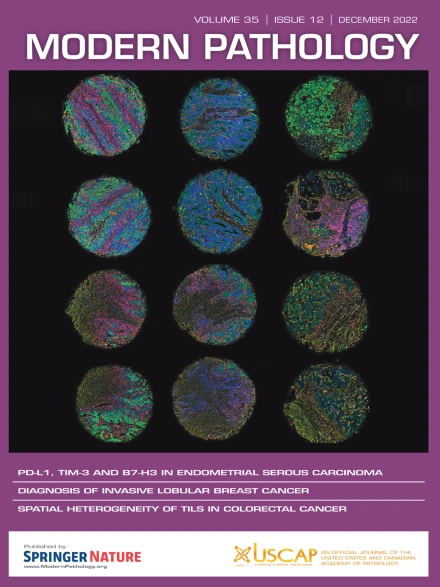Spatial Mapping of Gene Signatures in Hematoxylin and Eosin-Stained Images: A Proof of Concept for Interpretable Predictions Using Additive Multiple Instance Learning
IF 5.5
1区 医学
Q1 PATHOLOGY
引用次数: 0
Abstract
The relative abundance of cancer-associated fibroblast (CAF) subtypes influences a tumor’s response to treatment, especially immunotherapy. However, the gene expression signatures associated with these CAF subtypes have yet to realize their potential as clinical biomarkers. Here, we describe an interpretable machine learning approach, additive multiple instance learning (aMIL), to predict bulk gene expression signatures from hematoxylin and eosin-stained whole-slide images, focusing on an immunosuppressive LRRC15+ CAF-enriched TGFβ-CAF signature. aMIL models accurately predicted TGFβ-CAF across various cancer types. Tissue regions contributing most highly to slide-level predictions of TGFβ-CAF were evaluated by machine learning models characterizing spatial distributions of diverse cell and tissue types, stromal subtypes, and nuclear morphology. In breast cancer, regions contributing most to TGFβ-CAF-high predictions (“excitatory”) were localized to cancer stroma with high fibroblast density and mature collagen fibers. Regions contributing most to TGFβ-CAF-low predictions (“inhibitory”) were localized to cancer epithelium and densely inflamed stroma. Fibroblast and lymphocyte nuclear morphology also differed between excitatory and inhibitory regions. Thus, aMIL enables a data-driven link between histologic features and transcription, offering biological interpretability beyond typical black-box models.
苏木精和伊红染色图像中基因特征的空间定位:使用加性多实例学习进行可解释预测的概念证明
癌症相关成纤维细胞(CAF)亚型的相对丰度影响肿瘤对治疗的反应,特别是免疫治疗。然而,与这些CAF亚型相关的基因表达特征尚未实现其作为临床生物标志物的潜力。在这里,我们描述了一种可解释的机器学习方法,即加性多实例学习(aMIL),用于预测苏木精和伊红染色的整张幻灯片图像的大量基因表达特征,重点关注免疫抑制的LRRC15+富含caff的tgf - β- caf特征。aMIL模型准确预测了各种癌症类型的tgf - β- caf。对tgf - β- caf幻灯片水平预测贡献最大的组织区域通过机器学习模型进行评估,该模型表征了不同细胞和组织类型、基质亚型和核形态的空间分布。在乳腺癌中,对tgf - β- caf1高预测(“兴奋性”)贡献最大的区域定位于具有高成纤维细胞密度和成熟胶原纤维的癌间质。对tgf - β- caf1低预测(“抑制性”)贡献最大的区域定位于癌上皮和密集炎症间质。成纤维细胞和淋巴细胞核形态在兴奋区和抑制区之间也存在差异。因此,aMIL在组织学特征和转录之间建立了数据驱动的联系,提供了超越典型黑盒模型的生物学解释性。
本文章由计算机程序翻译,如有差异,请以英文原文为准。
求助全文
约1分钟内获得全文
求助全文
来源期刊

Modern Pathology
医学-病理学
CiteScore
14.30
自引率
2.70%
发文量
174
审稿时长
18 days
期刊介绍:
Modern Pathology, an international journal under the ownership of The United States & Canadian Academy of Pathology (USCAP), serves as an authoritative platform for publishing top-tier clinical and translational research studies in pathology.
Original manuscripts are the primary focus of Modern Pathology, complemented by impactful editorials, reviews, and practice guidelines covering all facets of precision diagnostics in human pathology. The journal's scope includes advancements in molecular diagnostics and genomic classifications of diseases, breakthroughs in immune-oncology, computational science, applied bioinformatics, and digital pathology.
 求助内容:
求助内容: 应助结果提醒方式:
应助结果提醒方式:


